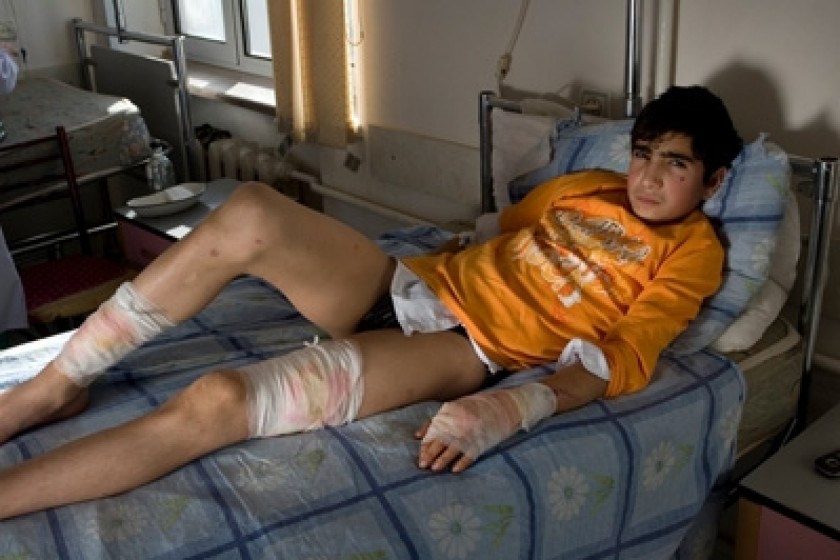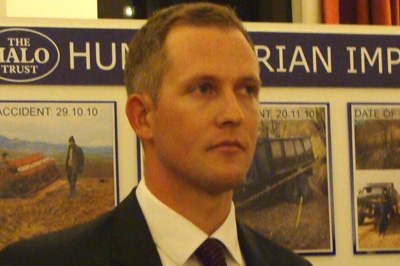
258 Mine and Unexploded Ordinance Accidents in Artsakh Since Cease-fire
On December 14 a 13-year-old Artur Khudatyan from Artsakh’s Hin Taghlar village (Hadrut region) found a cluster bomb just outside his village. He picked it up and tried to open it with an axe in the yard of his house. The bomb exploded.
”Artur is currently in Stepanakert Hospital and is extremely lucky to be alive. The cluster bomb does not appear to have fully exploded. If it had, it’s almost certain that Artur would now be dead,” HALO Trust Nagorno Karabakh Programme Manager Roly Clark told Hetq.
Artur received HALO Trust’s Mine Risk Education (MRE) at Hin Taghlar school last year. From 2003 to 2010, 40.388 children and 77.543 adults have been taught in the framework of MRE to raise their awareness of the dangers of mines and unexploded ordnance (UXO). MRE has been integrated into the Artsakh’s school curriculum and has the full support of the local authorities.
However, though MRE does prevent accidents, no amount of it will stop some children tampering with ordnance. Children are particularly at risk (25% of all of the fatalities and injuries are children) from mines and ordnance since they are naturally curious and when they see an object on the ground which looks interesting, they pick it up and start to play with it.
The accident which occurred to Artur is the 6th of the year in Artsakh, and the 4th in the last two months. Since 1995, there have been 258 mine and UXO accidents causing 329 injuries or fatalities in Artsakh. According to HALO Trust, this is among the highest per capita civilian casualty rates in the world. The highest number of accidents in Artsakh occurred in 1995 (33 accidents) and the fewest accidents occurred in 2009 (4 accidents).
 27 accidents occurred in 1999 and the same number, 27 accidents occurred in 2004. These are the biggest numbers of accidents till 1995. In Roly Clark’s words this is explained with the fact that in 1999 and 2004 wheat prices increased in the international market and more farmers started ploughing unused areas and suffered from mines and UXO.
27 accidents occurred in 1999 and the same number, 27 accidents occurred in 2004. These are the biggest numbers of accidents till 1995. In Roly Clark’s words this is explained with the fact that in 1999 and 2004 wheat prices increased in the international market and more farmers started ploughing unused areas and suffered from mines and UXO.
Farmers are another risk group. In some cases they knowingly risk cultivating fertile fields contaminated with anti-tank mines, desperate to sustain their families. A lot of the accidents in the last 2-3 years were caused to tractors being blown up by anti-tank mines.
HALO Trust started working in Artsakh in 2000. Since 2000 over 60.000 landmines, cluster munitions and other items of UXO have been located and destroyed. 2/3 of mines found and destroyed are anti-personnel and 1/3 are anti-tank ones. The mines and cluster munitions found in Artsakh are all of Soviet production.
Till now almost 80% (3,992 hectares) of all minefield area and 70% (20,609 hectares) of battle field area have been cleared. However, there are still minefields and cluster strikes remaining, for instance, in most regions along with the Eastern border of Artsakh and around Lachin corridor because of the restrictions of funding mine clearance in liberated territories.
HALO Trust has 3 donors at the moment. The funding provided by the British and American governments is not allowed to be used in liberated territories. The private funding HALO receives from the private charity foundation called “The Julia Burke Foundation” allows them to clear minefields and cluster strikes in liberated territories. “The Julia Burke Foundation” has been financing HALO for the last 3 years. Before it, in 2002-2009, the clearance of minefields in the liberated territories was conducted with the funding from the Dutch government.
HALO Trust employs 210 staff in Artsakh. All of them are local Armenians. The deminers are paid about 400 dollars per month. During 10 years 6 deminers have been injured when working but fortunately there have been no fatalities among them. HALO Trust’s current funding for 2010 is $1.9 million and the secured funding for 2011 is $1.5 million since the British government funding is coming to an end in January 2011. Because of the shortfall of 400.000 dollars HALO will face, 65 deminers will be made redundant and 250 hectares of minefields will not be cleared next year.
During 10 years the biggest donors of HALO Trust have been USAID, “The Julia Burke Foundation”, Dutch and British governments. The governments of RoA and Artsakh have not financed mine clearance in Artsakh during this period, but some private foundations in Armenia and the Armenian Diaspora in the US have.
HALO Trust needs $10 million to clear the remaining 20 percent of minefields and it will take 5 years. In Roly Clark’s words they are looking for support from all sources.
HALO has conducted mine clearance in historic sites, as well. They have cleared minefields close to Tigranakert. This year they have cleared cluster munitions right up against the slope from Gandzasar church. As for the unexploded ordnance that is stuck in the wall in Gandzasar, in Roly Clark’s words it is not dangerous since it is empty with no explosive in it.
“HALO was invited to Karabakh after the cease-fire in 1995. We first had a 18-month project to train up the Armenian military to clear the minefields. It became clear after we left that the problem was very big and we were invited back in 2000 by the Karabakh authorities,” Roly Clark said.
Azerbaijan has always very strongly objected to conducting mine clearance in Artsakh and often issues statements regarding clearance of minefields in Artsakh without bringing any rationale to those objections. HALO Trust doesn’t operate in Azerbaijan, the Azerbaijani authorities don’t want it.
HALO has completed a comprehensive General Survey of minefields and cluster bomb strikes in Nagorno Karabakh, providing an accurate picture of the amount of clearance that is still required. In Roly Clark’s words the maps of the areas that are not cleared of mines yet, are public information.
“All the information HALO has is public. So it’s no secrets. The thing is the mines that are not cleared don’t serve any military purpose. They are just blocking agriculture. And all the information comes from local people,” Roly Clark said.
In his words, in case of war HALO Trust would have to remain neutral. “If there is a war, then HALO has nothing to do with the fighting or anything,” Roly Clark said.
 Videos
Videos Photos
Photos




Write a comment